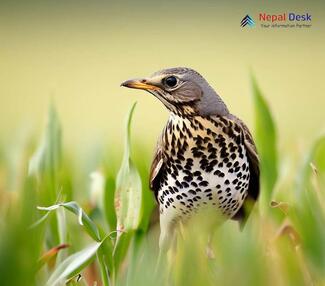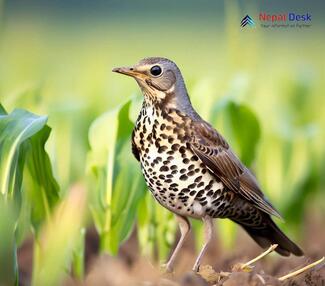The captivating Mistle Thrush, known scientifically as Turdus viscivorus, is an alluring bird species that grace various corners of the globe. In this article, we'll explore its classification and living environment while also taking a closer look at its unique presence within Nepal.
Decoding the Classification
As a member of the Turdidae family, the Mistle Thrush is an Old World species connected with other thrushes like the American Robin and Eurasian Blackbird. Its scientific moniker, Turdus viscivorus, stems from the Latin words 'turdus' (meaning thrush) and 'viscivorus', which refers to a fondness for dining on mistletoe berries. These birds can be spotted by their large stature, pale undersides with dark markings, and striking grayish-brown coats of feathers.
Venturing into the Habitat
The ideal home for Mistle Thrushes includes woodland areas that boast a blend of trees and open spaces. You may also spot them in parks, gardens, agricultural lands, and even cities. They create strong nests using grasses, roots, and twigs that are nestled in tree forks or along branches. During warmer months, Mistle Thrushes feast on invertebrates like earthworms, insects, snails, and slugs but shift to berries and fruits such as mistletoe (hence their name), rowanberries, hawthorn berries, and rose hips during chillier seasons.
Existence in Nepal
While these extraordinary birds primarily inhabit Europe and western Asia, recent discoveries have documented sightings within Nepal. In 2018, researchers confirmed a new record when they identified Mistle Thrushes near Koshi Tappu Wildlife Reserve. Demonstrating an amazing ability to adapt to diverse surroundings, Mistle Thrushes have successfully navigated the various ecological terrains of the country.
Their presence in Nepal is important because it highlights the adaptability and tenacity of this species. As our world faces climate change and habitat loss that impact global biodiversity, it becomes vital to record and safeguard ecologically essential creatures like the Mistle Thrush.
To wrap up, the Mistle Thrush (Turdus viscivorus) is genuinely an awe-inspiring bird that has captured the admiration of bird lovers everywhere. Its distinct appearance, preferred habitats, and surprising existence in Nepal serve as a reminder of the significance of preserving Earth's biodiversity. By expanding our knowledge about this species and its homes, we can support conservation initiatives that ensure a flourishing future for these magnificent birds.




